Vertebrate Skeletal Anatomy I - The Skull
John Merck
We use the example of Greererpeton burckemorani, a creature near the common ancestry of land vertebrates. As such, it displays all of the cranial elements of Sarcopterygii for which homologies are securely known, but very few of them are high transformed from their ancestral state.
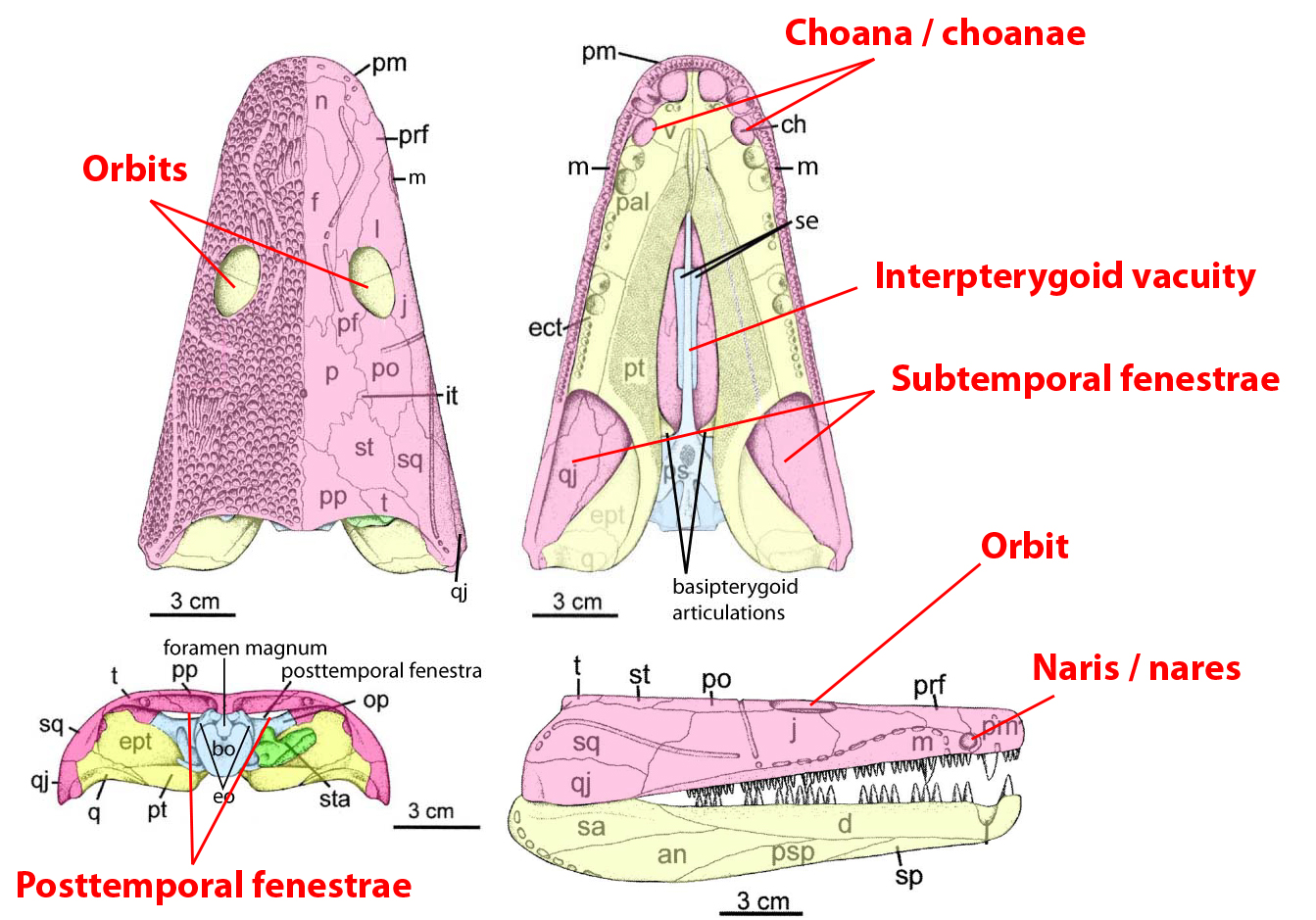
Greererpeton burckemorani
Greererpeton:
We continue to color-code:
- Blue: Ossifications of the neurocranium (dermal or endochondral)
- Yellow: Ossifications of the mandibular arch (dermal or endochondral)
- Green: Ossifications of the hyoid arch (endochondral)
- Pink: Ossifications of the skull roof (dermal)
- Orbits: Bony openings of eye sockets
- Nares (sing. Naris): Bony openings of nostrils
The palatal (ventral) aspect shows how ossifications of the skull roof, palatoquadrate, and neurocranium connect, but not too closely. Openings of the palate include:
- Choanae: (sing. Choana) Internal nostrils through which air enters oral chamber.
- Interpterygoid vacuity The space between the pterygoids (major ossifications of the palatoquadrate) on the midline
- Subtemporal fenestrae The "meat holes" through which the adductor muscles of the jaw pass.
Finally, the posterior view reveals:
- Posttemporal fenestrae Openings framed by the dermal skull roof and neurocranium.
In the course of vertebrate evolution, these openings are modified and, often, joined by new openings that we will need to keep track of. That's a story for later.
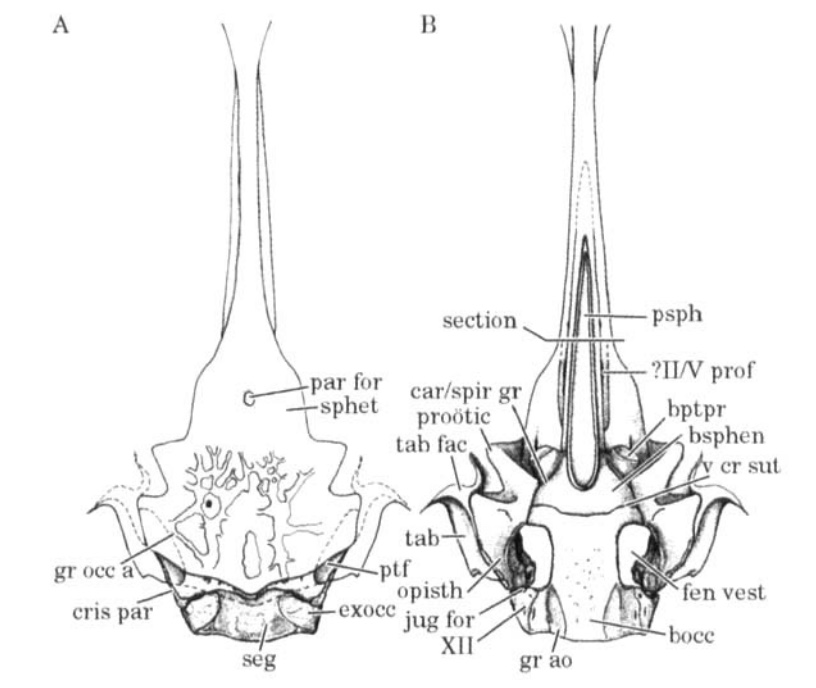
Acanthostega gunnari
The Neurocranium
We address Greererpeton's cranial osteology from the inside out. The neurocranium of Acanthostega shows in dorsal and ventral view the familiar trough-like shape.
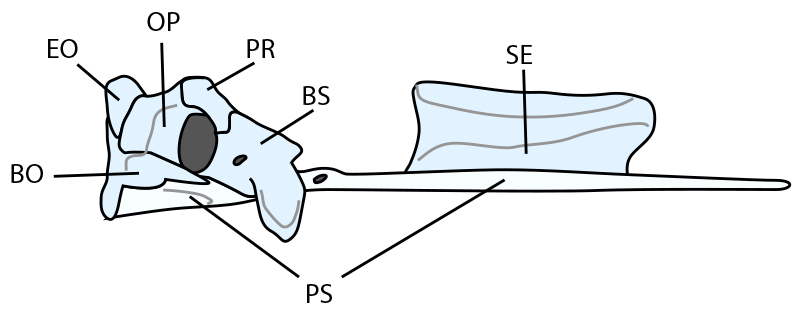
Greererpeton burckemorani
- PR - Prootic
- OP - Opisthotic
- EO - Exoccipitals
And midline elements the braincase floor:
- BO - Basioccipital: Ossification of parachordals that forms the basioccipital condyle.
- BS - Basisphenoid: Ossification of trabeculae forming the anterior floor of braincase, with special features:
- Basipterygoid processes Form the principal mobile articulation with ossifications of the palatoquadrate.
- Sella turcica - the "seat" of the hypophysis on the midline floor.
- PS - Parasphenoid: dermal ossification forming floor of braincase.
- SE - Sphenethmoids: In some tetrapods, paired elements form a trough through which the olfactory nerves are projected through the sphenoid region to the nasal capsules.
- Together frame these frame the lateral fenestra vestibule, a manifestation of the lateral cranial fissure which will become the opening through which airborne vibrations are passed to the otic capsule.
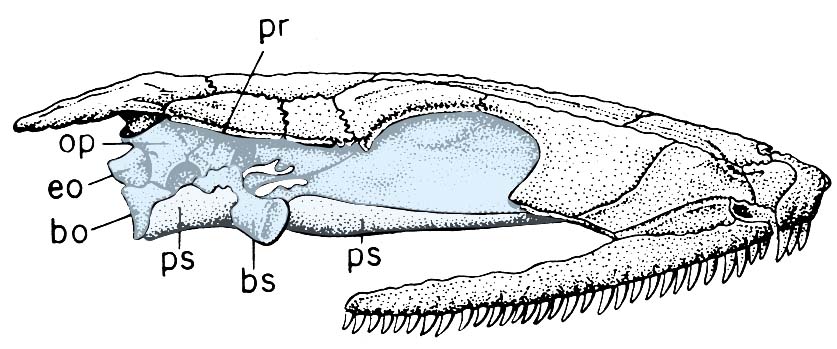
Paleoherpeton decorum
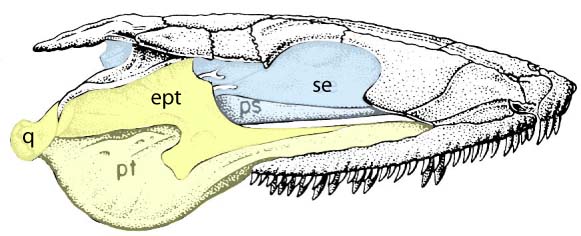
Paleoherpeton decorum
The Palatoquadrate
Parts of the actual palatoquadrate cartilage ossify as two endochondral elements in tetrapods. This is visible in the skull of an early tetrapod with the cheek and posteroventral orbital series removed.
- Q - Quadrate: The posteroventral corned that articulates with Meckel's cartilage.
- EPT - Epipterygoid: The dorsal portion that lies adjacent to the neurocranium.
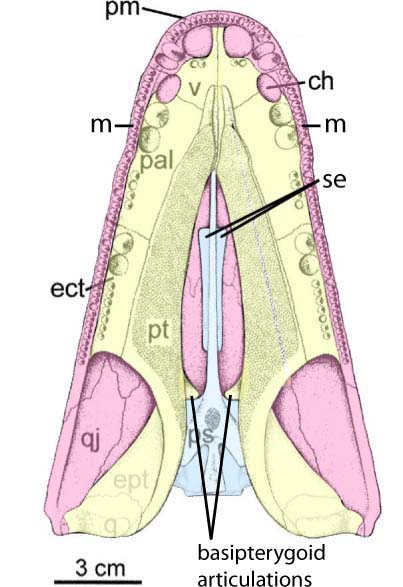
Greererpeton burckemorani
Ossification of the palatoquadrate:
- Dermal: Dermal ossifications of the ventral surface of the palatoquadrate. Note - any of these might bear teeth:
- v: vomer:
- pal: palatine:
- ect: ectopterygoid:
- pt: pterygoid: A large and complex bone. On the midline, they enclose an interpterygoid vacuity that may be wide, narrow, or closed. These articulate with the basipterygoid processes of the basisphenoid at the basipterygoid articulations.
The elements of the palatoquadrate are firmly sutured to the margin of the dermal skull roof, but they maintain mobile articulations with the neurocranium at the basipterygoid articulation.
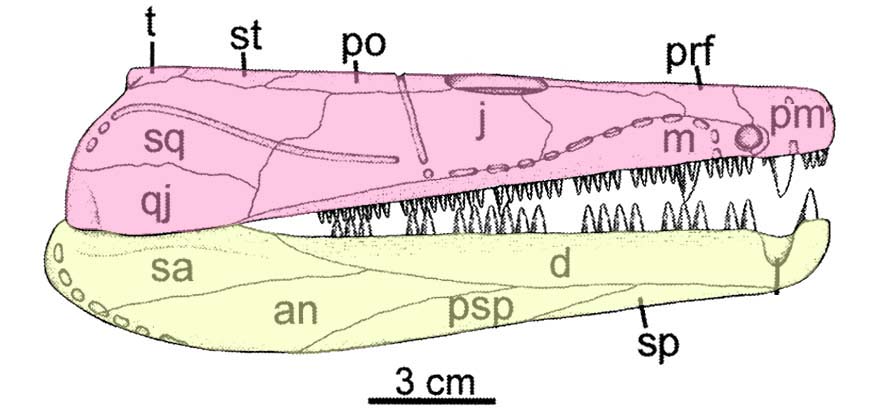
Greererpeton burckemorani
Meckel's cartilage:
Dermal elements sheathing Meckel's cartilage are visible:
- d: dentary: the primary tooth-bearing bone. Dentaries meet on the midline in a symphysis.
- sp: splenial: Abutting the dentary ventrally. Sometimes the splenial participates in the symphysis.
- psp: postsplenial: Continuing the splenial series posteriorly.
- an: angular: Forms the posteroventral angle of the jaw.
- sa: surangular: Forms the dorsolateral margin of the jaw posterior to the dentary.

Greererpeton burckemorani
- Adductor fossa: the opening through which the muscles that close the jaw insert onto the inner surfaces o the dermal bones and onto Meckel's cartilage.
- art: articular: Endochondral. Direct ossification of Meckel's cartilage that articulates with the quadrate ossification of the palatoquadrate.
- part: prearticular: Forms the medial margin of the adductor fossa.
- co: coronoids: A series of elements medial to the dentary that often bear teeth as well.
- a fenestra: By odd happenstance, Greererpeton has a fenestra (window) on its medial jaw surface. Fenestrae can occur anywhere in the dermal roof of vertebrate skulls, and are often of great value in determining what you are seeing.
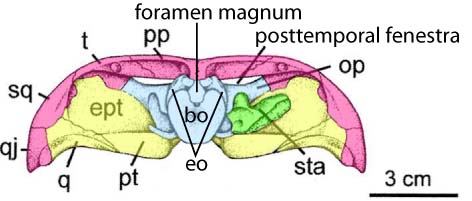
Greererpeton burckemorani
- The neurocranium contacts:
- the skull roof through the paroccipital processes of the opisthotic. Together they enclose a pair of posttemporal fenestrae
- the palatoquadrate through the basipterygoid articulation (not visible in this view). Together they enclose a cranio-quadrate passage
- sta: stapes: What is the green thing? (Shown on one side only.) In fact, it is the hyomandibula, which in land vertebrates is repurposed for use in hearing and called the stapes. (It focuses vibrations picked up by the mandibular arch onto the fenestra vestibuli, a persistent opening in the lateral occipital fissure.) In Greererpeton it probably serves both its original and its new function to some degree.
Test yourself with Proterogyrinus scheelei:
Test yourself with extant vertebrates:
